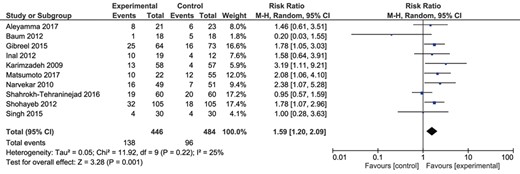-
PDF
- Split View
-
Views
-
Cite
Cite
Sagiri Taguchi, Miyako Funabiki, Yoshitaka Nakamura, Adherence to review protocol and rigorous methodology are the pre-requisites of a well-conducted systematic review, Human Reproduction Update, Volume 25, Issue 6, November-December 2019, Pages 803–804, https://doi.org/10.1093/humupd/dmz023
Close - Share Icon Share
Sir,
In a recent review, Sar-Shalom Nahshon et al. (2019) argued the impact of intentional endometrial injury (scratching) on reproductive outcomes by systematic review and meta-analysis. However, we have found a discrepancy in the clinical pregnancy rate—two or more failed IVF cycles—between Fig. 5 in the study of Sar-Shalom Nahshon et al. (2019) and Fig. 2C (8.2.2) in the study of Vitagliano et al. (2018), notwithstanding the fact that both studies analyzed randomized controlled trials (RCTs) published between 2009 and 2017 for their meta-analyses. Figure 5 in the study of Sar-Shalom Nahshon et al. (2019) did not show the significant improvement of clinical pregnancy rate—two or more failed IVF cycles—(risk ratio, 1.53; [95% CI, 0.93–2.51]; P = 0.09) by endometrial injury (scratching) in the DerSimonian–Laird random effects model. However, Fig. 2 C (8.2.2) in the study of Vitagliano et al. (2018) showed significant improvement of clinical pregnancy rate—two or more failed IVF cycles—(risk ratio, 1.44; [95% CI, 1.14–1.84]; P = 0.006) by endometrial injury (scratching) in the DerSimonian–Laird random effects model. Although this discrepancy may be caused by the differences of selected RCTs in these two meta-analyses, we have updated the meta-analysis for the impact of endometrial injury (scratching) on clinical pregnancy rate—two or more failed IVF cycles—by using published data for the both studies (Vitagliano et al., 2018; Sar-Shalom Nahshon et al., 2019) and RevMan 5.3 (Cochrane Collaboration, Oxford, UK). Then, the clinical pregnancy rate—two or more failed IVF cycles—was analyzed on an intention-to-treat basis in our meta-analysis, in contrast to Sar-Shalom Nahshon et al. (2019) who did not always analyze on an intention-to-treat basis in their meta-analysis. As a result, unlike the contention of Sar-Shalom Nahshon et al. (2019), we have found a significant improvement of clinical pregnancy rate—two or more failed IVF cycles by endometrial injury (scratching)—(n = 930; risk ratio, 1.59; [95% CI, 1.20–2.09]; P = 0.001) in the DerSimonian–Laird random effects model (Fig. 1). Furthermore, according to Cochrane Handbook for Systematic Reviews of Interventions (https://training.cochrane.org/handbook), 0–40% in an I-squared statistic might not be important and was considered as a low level of heterogeneity. Therefore, our meta-analysis would be considered as a low level of heterogeneity and could show a significant improvement of clinical pregnancy rate in women who had had two or more failed IVF cycles by endometrial injury (scratching) (Fig. 1), while current evidence did not support performing endometrial injury (scratching) with the purpose of improving the success of the first and second embryo transfer attempt (Frantz et al., 2019; Vitagliano et al., 2019). However, in most RCTs for endometrial injury (scratching) among infertile women, endometrial injury (scratching) was conducted in luteal phase, including recent RCTs (Frantz et al., 2019; Lensen et al., 2019). The only randomized controlled study (Shohayeb and El-Khayat, 2012) for endometrial injury (scratching) included in the meta-analyses of RCTs (Vitagliano et al., 2018; Sar-Shalom Nahshon et al., 2019; Vitagliano et al., 2019) was conducted in follicular phase. The endometrial injury (scratching) in follicular phase in the study of Shohayeb and El-Khayat (2012) did result in a higher rate of live birth than no intervention (risk ratio, 2.00; [95% CI, 1.12–3.58]; P = 0.02) in the DerSimonian–Laird random effects model (Vitagliano et al., 2018). Furthermore, the study of Shohayeb and El-Khayat included 200 infertile women with repeated implantation failures (two or more failed IVF cycles) (Shohayeb and El-Khayat, 2012; Vitagliano et al., 2018).
Considering the above-mentioned matters, the study for endometrial injury (scratching) is not `Time to Stop’ (Mol and Barnhart, 2019) but `Time to Try in Follicular Phase’ among the infertile women with repeated implantation failures.

Update meta-analysis of RCT (clinical pregnancy rate—two or more failed IVF cycles by endometrial injury (scratching)).
Conflict of interest
None.
References
Author notes
Sagiri Taguchi, Miyako Funabiki and Yoshitaka Nakamura contributed equally to this work.



